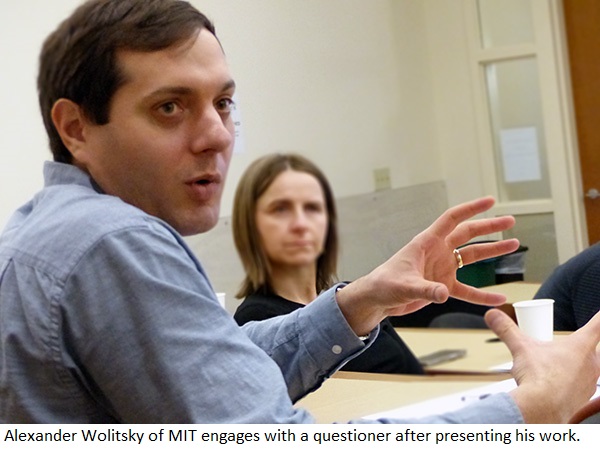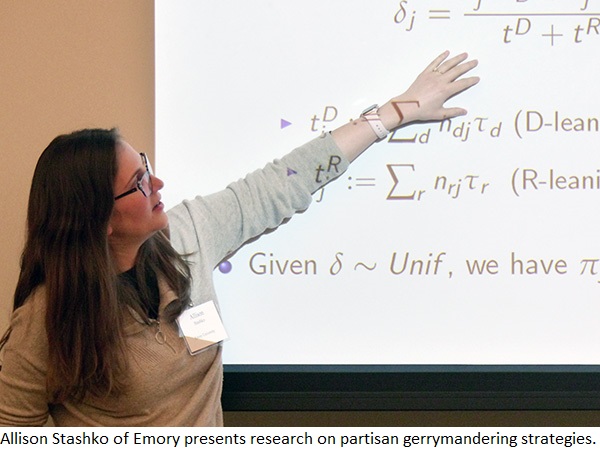Democracy Under the Lens: Insights from ISPS Conference on Political Power

When political parties engineer voting maps to their advantage, the resulting legislative districts can resemble two formless amoebas joined by a twisting strand of spaghetti.
In fact, such gerrymandered districts got their name in 1812, when Massachusetts Gov. Elbridge Gerry signed a bill creating a partisan district in Boston that observers likened to the shape of a salamander. Then and today, such districts might make little sense from the perspective of geography or representative democracy. Gerrymandering simply serves to maximize a one party’s ability to gain, maintain, or grow a majority of legislative seats.
How does gerrymandering work in practice? How do other evolved levers of political power — such as the U.S. Senate’s filibuster rule — contribute to outcomes? The Institution for Social and Policy Studies’ Democratic Innovations program gathered experts to Yale last week to answer these and similar questions for a conference on “Political Power in Democracies.”
“There has been a lot of research in both economics and political science on the effects of organizing democracy in different ways,” said Danil Dmitriev, a resident postdoctoral associate with the Democratic Innovations program. “But in my view, there has not been as much attention paid to the unintended consequences and adverse effects of allocating uneven political power to certain players in the government.”
Dmitriev and Adam Meirowitz, ISPS faculty fellow, Damon Wells Professor of Political Science, and co-leader of Democratic Innovations, organized the one-day conference as part of the program’s mission to identify and test new ideas for improving the quality of democratic representation and governance.
“It was exciting to draw scholars from both economics and political science to think about how democratic institutions still provide opportunities for clever officials to bias outcomes towards their goals,” Meirowitz said. “Through the presentations, questions, and discussions, I felt everyone left with a better appreciation of this fertile topic, new opportunities for collaboration, and fresh ideas to explore.”
Freddie Papazyan, assistant professor of economics at Texas Tech University, presented his model on how “power and resources inevitably fall into the hands of a few when political competition is left unchecked in large societies.”
Alexander Hirsch, professor of political science at California Institute of Technology, presented his work with a colleague showing how the presence of veto players in lawmaking, a feature of democratic institutions thought to promote stability, might be a force for increased bias when politicians compete to craft high quality policies that also have an ideological leaning.
Alexander Wolitzky, professor of economics at Massachusetts Institute of Technology, shared his work with a colleague evaluating the effectiveness of gerrymandering strategies depending on the level of districtwide uncertainty concerning the number of votes the gerrymandering party might receive in an election and the individual uncertainty regarding which voters will vote for their party.
“Rigorous modeling of how the institutions of democracy are shaped and exploited by strategic actors, yields important theoretical insights, and it is an essential to guide both empirical research and policy recommendations,” said Alan Gerber, ISPS director and Sterling Professor of Political Science. “The outstanding work featured in this conference organized by Danil and Adam shows how mathematical modelling of political institutions can deepen our knowledge and promises to lead to better systems of representation and political decision making.”
The most common gerrymandering method is called “cracking and packing,” by which political actors in part seek to divide voters more likely to support the opposition party into as many districts as possible (cracking), thus reducing their ability to form a majority in those districts’ races. Similarly, the gerrymandering party can limit the damage to their own overall representation by packing likely opposition voters into the fewest number of districts possible, creating lopsided outcomes in which excess votes are more-or-less wasted.
When asked about partisan gerrymandering in surveys, most Americans consider the practice a big problem for our democracy. They recognize that these are not natural borders or fair legislative districts in which voters are free to select the representative of their choice. This affects which polices get adopted into law and how resources are distributed.

“If we want to be able to maybe curtail partisan gerrymandering, or at least identify it properly, we need a really good understanding of what the partisan gerrymander looks like,” said Allison Stashko, assistant professor of quantitative theory and methods at Emory University. “And that’s the motivation for studying the strategy from the perspective of a gerrymanderer.”
Stashko presented her work with colleagues on a model in which successful partisan gerrymandering would include voters’ likelihood of turning out for elections.
Wolitzky said researchers in the fields of economics, political science, law, public policy, statistics, and computer science have delved into gerrymandering.
“A conference like this is very valuable for the types of interactions and new ideas it generates,” he said, noting that Stashko’s presentation included a data source that he had been unaware of and that he and his colleagues might now incorporate into their work. “It’s fantastic to gather people all working in this area.”
Dmitriev said he was happy he and Meirowitz helped facilitate such interactions and hoped the work would continue to spread.
“Our goal for this conference was both to connect researchers studying this topic so they can collaborate and to highlight to the greater research community that political power can have interesting and unintended effects on what kind of laws get passed and what kind of outcomes we get in elections,” he said. “We want to understand better how political power is used and misused. And in gaining a better understanding, help determine what we might need to change about how our democracy works.”